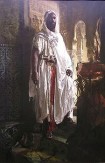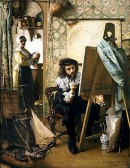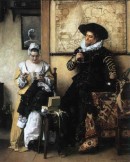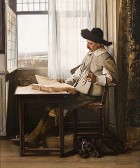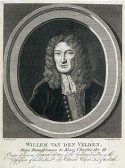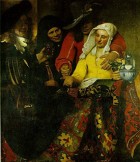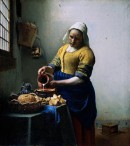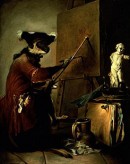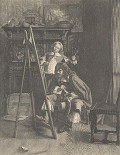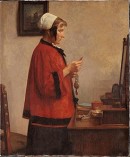The browser will either open the file, download it, or display a dialog.

Eduard Charlemont's Artist in his Studio
One of the most popular paintings in the Philadelphia Museum of Art is The Moorish Chief (fig. 1) by the Austrian-born artist Eduard Charlemont (1848–1906). According to the museum's website, the gift shop sells more reproductions of this painting than of any other artwork in the museum.[1] This proud record notwithstanding, Charlemont is little known today, even among historians of nineteenth-century art.
The accounts of Charlemont's life differ in many details, but there is general agreement that he was born in Vienna in 1848.[2] His father was a painter of miniature portraits; his brothers Hugo (1850–1939) and Theodor (1859–1938) were artists as well, the first a painter, the second a sculptor. Eduard was taught painting by his father and completed his training at the Vienna Academy, where he studied with Eduard von Engerth (1818–1897) and Hans Makart (1840–1884). He subsequently took a prolonged trip to Italy and also traveled elsewhere in Europe as well as to North Africa. Some time in the 1870s or 1880s—accounts differ on this point—he settled in Paris, where, some believe, he stayed until the end of the century.[3] He died and was buried in Vienna in 1906. Charlemont regularly exhibited at the Paris Salons as well as at international exhibitions of the second half of the nineteenth century, receiving a bronze medal at the Paris International Exposition in 1900. In addition to easel paintings, he did numerous murals, mostly in and around Vienna. In the 1880s, he and his brother Hugo were part of an army of artists (which also included the Klimt brothers), charged with creating the painted decorations of the Vienna Burgtheater, built by Carl von Hasenauer and Gottfried Semper.
In France, Charlemont was respected as a portraitist and a painter of historic genre scenes, set mostly in the seventeenth and eighteenth centuries. Artist in his Studio (fig. 2) of 1890, the subject of this "New Discovery" article, is one of several works that are inspired by Dutch seventeenth-century genre painting. These include The Lacemaker (La Dentellière; fig. 3) of 1889, and Interior (Scène d'intérieur; fig. 4), a painting that is undated but that probably was painted in the late 1880s.
Artist in his Studio has an interesting provenance, as it was once owned by Jean-Baptiste Faure (1830–1914), the famous French operatic baritone, who was an important art collector.[4] Faure is known today as a patron of the Impressionists, but when he first started collecting his focus was on Academic, Barbizon, and Realist paintings.[5] In 1873 and again in 1878 he auctioned off many of these works, but apparently he continued to buy some academic paintings. Artist in his Studio did not remain in his collection for a long time. Faure must have bought it shortly after it was painted in the early 1890s; it was sold at auction in New York in 1898.
Artist in his Studio is noteworthy as a virtuoso pastiche of Dutch seventeenth-century painting, combining several genres—portrait, genre, still life, and marine painting—and styles. It represents an artist, painting at his easel, who has been identified, in turn, as "Van de Velde" and as Johannes Vermeer.[6] The latter identification is doubtful as the artist appears to be painting the model of a ship—not a subject Vermeer ever treated in his work. As to the former, Bainbrigg Buckeridge, in his "Essay towards an English School" (1706), mentions that Willem van de Velde the Elder "had a model of the masts and tackle of a ship always before him, to that nicety and exactness, that nothing was wanting in it, nor nothing unproportionable."[7] This anecdote, which apparently was well-known in the nineteenth century, may have informed Charlemont's painting. Since the artist looks young and the setting Dutch, Charlemont may have intended to depict Van de Velde as a budding painter, before he moved to England around 1672. No portraits of Willem van de Velde the Elder are known, except for one that represents him at an advanced age (fig. 5); it bears little resemblance to Charlemont's artist. This image of the artist, if indeed it meant to represent Willem van de Velde, must be considered imaginary.
While the identification of the artist with Vermeer is unlikely, it is not entirely arbitrary. Dressed in black, with a large white lace collar, the artist vaguely resembles the figure on the left side of The Procuress (fig. 6), which has often been identified with the young Vermeer. More importantly, the kitchen scene, on the left, seen through an arched opening in the rear wall, recalls Vermeer's painting, The Kitchen Maid (fig. 7), not only in the light blue and yellow tones used for the woman's clothes, but also in the deep chiaroscuro of her face, and the white background. Other details, such as the map on the wall, also are reminiscent of Vermeer's paintings, though they occur in the works of other Dutch genre painters as well.
If Charlemont shows off his intimate knowledge of the history of Dutch seventeenth-century painting in this work, he also demonstrates his mastery of painting textures, in the manner of such Dutch genre painters as Frans van Mieris and Gerard Terborch, or eighteenth-century French artists like François Boucher and Jean-Baptiste Chardin. The still life in the lower right corner, composed of the easel, draped in a large piece of light-blue brocade, as well as a folder with drawings and a Delftware pot with brushes, shows some resemblance to the still life in Jean-Baptiste Chardin's The Monkey Painter of 1740 (fig. 8).
Charlemont belonged to the last generation of nineteenth-century, especially French, painters to take a serious interest in Dutch seventeenth-century art. The first generation was represented by such artists of the Empire as Léopold Boilly, Martin Drolling, Marguérite Gérard, and some of the peintres troubadours (such as François Fleury-Richard); the second by the Realists (Gustave Courbet, François Millet, François Bonvin) as well as, simultaneously, by such academic genre painters as Ernest Meissonnier. Charlemont belongs to a third generation, which continued the tradition of Meissonnier, but often on a slightly larger scale. Indeed, their works lack the miniaturist aspect of Meissonnier's work as well as its anecdotal character. It is instructive to compare Charlemont's painting with Meissonier's The Brothers Adriaen and Willem van de Velde (fig. 9) of 1856in the Metropolitan Museum of Art, a work that represents the two sons of Willem van de Velde the Elder in a studio. Measuring 10 5/8 by 8 3/5 inches, the painting is not only much smaller than Charlemont's Artist in his Studio, but it also shows more action, and more interaction between the figures, as one of the brothers is painting and the other appears to be judging his work. The difference between Meissonnier's genre scene and that of Charlemont is analogous to the difference between a painting by Gerard Terborch and one by Johannes Vermeer. The latter had been "rediscovered" by the French art critic Théophile Thoré in an article written in the Gazette des Beaux-Arts in 1866. The acquaintance with Vermeer's work changed the way French artists looked at Dutch genre painting, causing them to admire the stillness and monumentality of late seventeenth-century Dutch domestic scenes rather than the anecdotal character of similar paintings done during the early seventeenth century. In this regard, Charlemont's paintings may be compared with some of the works of Emile Troncy (1859–1943) (fig. 10), who likewise was attracted to the still and silent figures found in Vermeer's mature works. Both Charlemont and Troncy are representative of the last generation of European academicians—artists who were not only highly skilled, but also interested and well-versed in the history of art, which served them as a source from which they liberally and manifestly drew their inspiration.
Petra Chu
Seton Hall University
Petra.chu[at]shu.edu
[1] See http://phillymuseumofart.com/education/resources/63.html, (accessed Jan. 3, 2010).
[2] Some authors have his birthplace as Znaim, in Moravia (now Znojmo, Czech Republic) but that may be the result of a confusion between Eduard and his brother Theodor.
[3] The varying accounts of the length of Charlemont's stay in Paris may be because, in all likelihood, he traveled back and forth between Paris and Vienna, depending on commissions, exhibitions, etc.
[4] Information about the provenance of the painting was obtained from the painting's current owner, Schiller & Bodo Fine Art, in New York.
[5] I thank Anthea Callen for the information about Faure's collecting history.
[6] In the catalogue of the 1898 sale in New York (Ortgies Galleries, April 13,1898), the painting was called The Artist Van de Velde in his Studio; later, when it was sold at Christie's in London (November 18, 1994, lot 135), it was called Vermeer in his Studio; most recently, at a Sotheby's sale in New York (May 23, 1997, lot 172), it was called Vermeer in his Studio. The painting is reproduced in Hans Kraan, Dromen van Holland: Buitenlandse Kunstenaars Schilderen Holland, 1800-1914 (Zwolle: Waanders, 2002) with the title "Vermeer in zijn Atelier."
[7] Bainbrigg Buckeridge, The Art of Painting, with the Lives and Characters of Above 300 of the Most Eminent Painters. A Translation of Roger de Piles's "L'Abrégé de la vie des peintres." To which is Added, An Essay Towards an English School, 3rd ed. (London: printed for T. Payne, 1754), 432.


